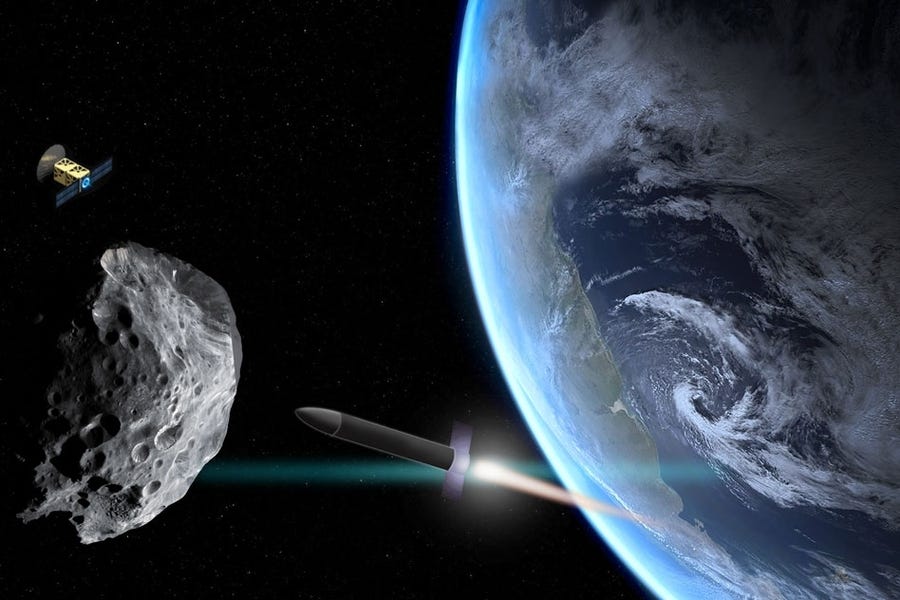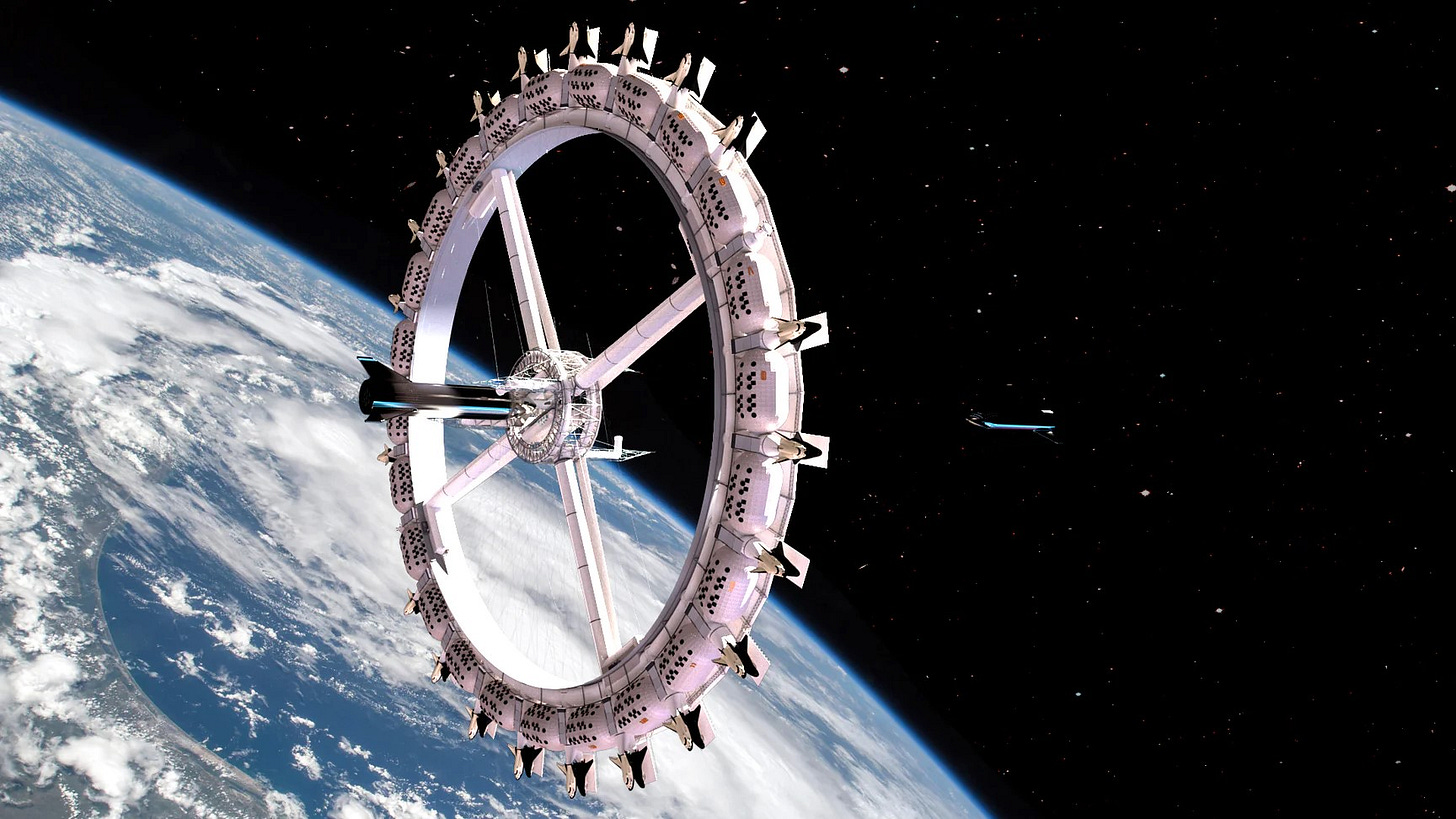With the possible exception of the Apollo program, the space effort has remained relatively small scale to-date due to the inherently high cost of launching from Earth. However, this can be viewed as a transient plateau as we now ascend to a new era of massive space utilization. Emerging Super Heavy Lift (SHL) launch vehicles like, New Glenn and Starship can shoulder prodigious payloads, and, with the addition of orbital refueling, send these payloads to deep space or far worlds. Unlike Apollo, these new SHL vehicles are designed to be fully reusable, ideally reducing their launch cost to little more than the price of propellant.
This suggests many space exploits previously deemed impossible have now become a distinct reality. However, the future is never quite what we imagine, yet as it draws closer we begin to see it more clearly – like through a glass darkly…
Space Infrastructure
Finding ourself in enviable possession of cheap and readily available space access, what are the priorities, i.e. what can we reasonably expect to see first from our burgeoning space infrastructure: -
Defense Station – as previously discussed, the Defense Innovation Unit, backed by Space Force, will likely take this opportunity to create an orbital space station. For example, a manned station could be located at Geostationary Earth Orbit (GEO), to secure this strategically important sector of space situated directly above the US. In addition, a GEO station would allow good oversight of proliferated Low Earth Orbit (LEO) and Medium Earth Orbit (MEO) constellations, helping to protect them from untoward interference e.g. dazzling, jamming, interception etc.
Asteroid Defense – on average we can expect to be hit by an over-sized asteroid every hundred years – and the last such event was Tunguska in 1913… On July 13 an asteroid called 2023 NT1 came alarmingly close to Earth and was detected very late, in fact 2 days after it barely missed us. If this relatively small asteroid had hit a landmass, the effect would be similar to a hydrogen bomb. However, if it had fallen into our largest ocean, i.e. the Pacific, the resultant tidal wave could have ended the global economy. Given the public concern, asteroid defense will likely become a priority once we improve our detection capabilities and space access.
The simplest method to alter an asteroid’s course is to impact it with a large mass, such as a spacecraft. Unfortunately many potential asteroid threats are discovered relatively late, which means more mass is required to deflect them, particularly for larger bodies. Fortunately our new generation of spacecraft are designed to loiter for long periods in space, therefore one could be parked relatively close to an orbital propellant depot that’s kept at full capacity. Then the vigilant spacecraft could be quickly refueled and dispatched to intercept any incoming asteroid threat at relatively short notice. For example, Starship weighs-in at ~100 tonnes, plus any unspent propellant, enough mass to ward against anything except the mightiest asteroid. Likely any kilometer+ asteroid will be detected fairly early, hence the relatively small deflection applied by Starship should be sufficient for it to miss Earth, due to the vast distance it must travel before reaching us.
Green Space - there’s a lot of redundant hardware in space, such as spent stages or non-functional satellites.
“As of November 2022, the US Space Surveillance Network reported 25,857 artificial objects in orbit above the Earth, including 5,465 operational satellites.” ~ Wikipedia
Fortunately anything in LEO will likely burn up in the atmosphere in a few decades, effectively resolving this problem. However, hardware at higher orbits, such as MEO or GEO, present long-term hazards, particularly as they are likely to disaggregate over time and damage other space vehicles. The most effective way to deal with these potential hazards is to remove them while still whole, something made economically viable with cheap space access. Objects in MEO operate at different inclinations and altitudes making them difficult to collect. However, they could be intercepted and deorbited by a reusable space tug, which could be refueled at the propellant depots stationed in LEO. Interestingly objects at GEO present a real commercial opportunity, they orbit in a relatively tight ribbon above the equator hence can be retrieved en masse. This redundant space hardware could then be reduced into component materials and sold as feedstock for orbital manufacturing, with the GEO defense station a readymade customer. The US Space Force has offered to pay for space clearance, which implies any operator could first be paid to remove dysfunctional satellites and stages then paid again to deliver feedstock – overall a great business opportunity.
Space Carriers – large scale space travel requires large scale space vehicles. Lifting spacecraft out of Earth’s deep gravity well takes an enormous amount of energy, and places significant stress on the vehicle. Logically it’s preferable to launch once then operate the spacecraft exclusively in space thereafter. If these space carriers are constructed in orbit from modular components, they could be vast, instead of restricted by the size of the launch vehicle. This would make them capable of carrying thousands of people in relative comfort or transporting unusually heavy cargo. Likely such large vehicles would require some form of nuclear propulsion, although there are many options available. Frankly the list of potential benefits offered by space carriers is mouth-watering: -
Centrifugal gravity, to mitigate space sickness and deconditioning
Active and passive radiation shielding, to protect spacecraft systems and passengers
High seating capacity vehicles can be used to load and unload passengers, to reduce the overall number of launches required
Speedier transit due to nuclear engines/not restricted to Hohmann transfer window
Closed ecosystem to conserve air, food and water, to minimize reprovisioning flights and allow long duration missions
Succinctly: scale is commercial.
Space Settlement and Tourism
As we enter the era of large scale space operations, the amount of hardware and people transported to new worlds, like the moon and Mars, will be unparalleled. By necessity they these new worlds will produce much of the commodities and equipment they need to survive themself, instead of relying on delayed and costly shipments from Earth. Effectively these settlements will operate their own internal economies, capable of supplying all staple goods and support services. SpaceX have big plans for the moon and Mars, Blue Origin want to refine lunar regolith into raw materials to produce complex products and move manufacturing into orbit. At present, relatively few goods can be manufactured in space that are financially viable for Earth, however, there will likely be enormous demand for all manner of goods for space stations.
Plans for quite expansive space stations are being pursued by serious players, such as Blue Origin’s Orbital Reef and SpaceX’s Starship Station. Likely these will become the forerunners for even larger constructs, culminating in rotating space stations. Humans have evolved to live in gravity hence require a substitute, like spin gravity, to remain healthy in a microgravity environment. Once established, these large rotating stations will largely operate their own micro-economies, trading virtual products with other stations and settled worlds.
At present space is largely the preserve of ultra-fit astronauts, due to the stress of microgravity and radiation exposure over extended periods. However, the new destinations in space and other worlds should have sufficient gravity and radiation protection to allow anyone to live and work there; then the flood gates should open to space tourism and all manner of business applications.
Final Destination
“A new philosophy of the future is needed. I believe it should be curiosity about the Universe – expand humanity to become a multiplanet, then interstellar, species to see what’s out there... Sub lightspeed is all that’s needed to be interstellar.” ~ Elon Musk
While there are many good and valid places to settle in our solar system, none will be as habitable as our Earth – at least for centuries. However, it’s becoming increasingly clear that most stars support rocky planets like our own, some of which promise to be eminently habitable. From what we observe, sentient life appears the exception in our galaxy, hence these new worlds are ideal for colonization, once we gain the capability.
In Conclusion
Taking a step back, the massive scaling of space infrastructure and settlements within our solar system could be viewed as gathering ourself before the mighty leap farther. Certainly the culture of stoicism and self reliance engendered in these new space settlements would be an incredible boon on any interstellar expedition. Due to the incredible distances involved, most expeditions will effectively become generational efforts, completely isolated from Earth. All this sounds a long way off, like the prospect of landing on the moon in the 1950s… Similar to the concerted effort shown by the Apollo program in the succeeding decade, all this is now within our grasp, given the advent of commercial SHL vehicles and space transport.
In the final analysis space is imponderably large, so to successfully traverse it we must take our civilization with us in microcosm. It seems bigger is certainly better in this regards.






Great run down of the importance of scale. We live in exciting times. One can only hope that Starship, New Glenn, and the LM-9 live up to their reusability goals.
You may like my quick write up on the LM-9 because its design is also evolving along a similar pathway to Starship: https://www.lianeon.org/p/a-look-at-chinas-reusable-super-rocket